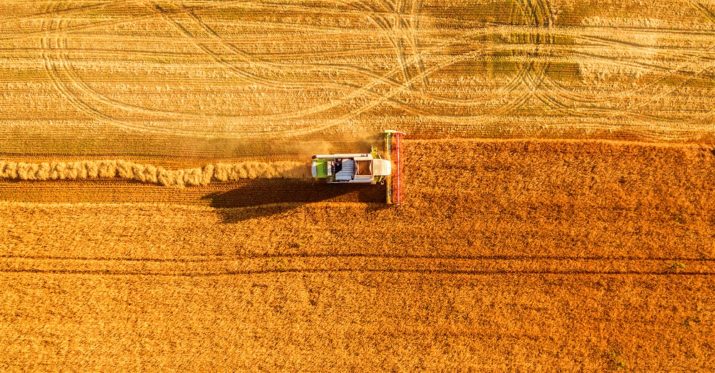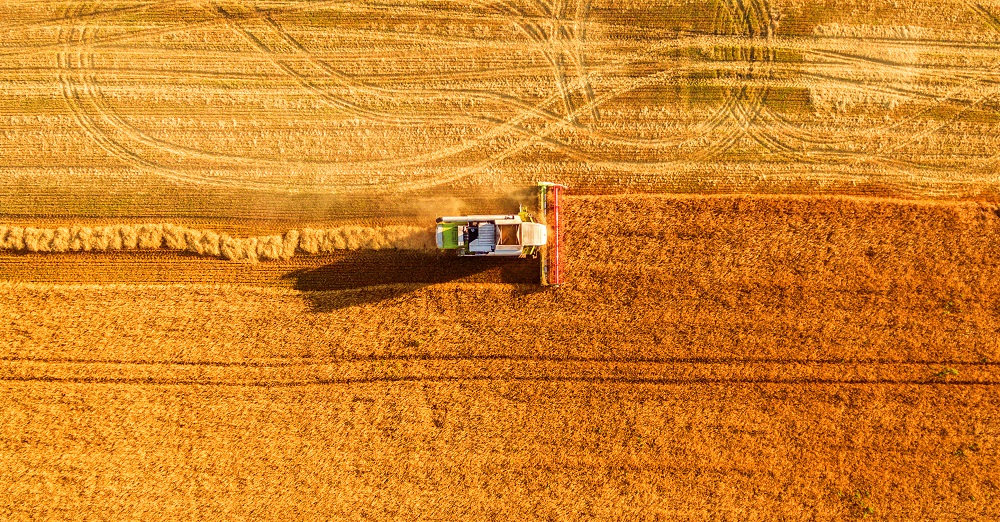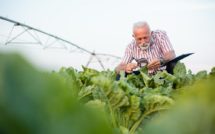

An introduction to our special feature on Food, Food Systems, and Agriculture.
It is estimated that 40 percent of the planet’s ice-free land is dedicated to agriculture. However, in Europe alone, the twentieth century has witnessed radical transformations in agrarian economies. The consequences of two ravaging world wars, advancements in technologies and the mechanization of many food-related activities, as well as the ensuing professionalization of agriculture and adjustments in lifestyles have all contributed in many nations to the decline of rural cultures. Those factors have also been closely associated with the emergence of new foodways and a change in production scales, although they have been uneven across the European Union with, in particular, a marked difference between east and west and to some extent between north and south as well. In the late twentieth and twenty-first centuries, the acceleration of economic, political, and cultural globalization has further led to the integration of agriculture into wide-scale systemic arrangements and deregulated supply chains. This situation in turn has led to an international division of labor and increased rural poverty in those places where access to land has become more difficult. Another consequence is that the very function of rural areas has changed away from food production to more varied uses as residential, heritage, or recreational spaces. It is also important to mention that today’s agriculture does not only produce foodstuffs. Serious conflicts have arisen in recent decades in the face of the expanded allocation of land across the globe to biofuel agriculture in service to the insatiable appetite modern societies have for energy, with all the corollaries that this creates, such as land grabbing or encroachment into vulnerable territories, food insecurity, and disregard for powerless populations. However, this special feature focuses on tackling the food sector, while recognizing that both energy systems and food systems constitute two sides of the same coin, both raising issues of inequity in control and access, uneven geographies of supply and demand, environmental degradation and unsustainability, and hyper-consumption and waste.
“Food systems” represent the array of processes, actors, and practices that pertain to the production, transformation, transport, distribution, consumption, and disposal of food. They include all the steps necessary for food to be provisioned to populations and the ways in which food is being accessed and ingested, as well as the ways in which communities organize around food to celebrate, worship, protest, transmit their heritage, or simply be together. Many are those troubled that long global food supply chains have caused production and consumption to become disjoined. The social and economic imbalances thus created have triggered the need to reinvent consumption to make it more critical and to conceive of new production methods that are more socially engaged. Food is where nature meets culture and, as such, food systems offer a rich terrain of interdisciplinary inquiry that EuropeNow highlights in this special feature by showcasing a breadth of stimulating research endeavors that explore different but interrelated aspects of those systems. The articles and interviews included here clearly convey that food stands as an entry point into a wide range of contemporary and historical debates that touch all humans. What is more, they also indicate that food operates as a spatial and temporal link across a complex web of interconnected social, cultural, political, economic, environmental, demographic, nutritional, and physiological topics. Moreover, the contributions in the feature demonstrate that these linkages must be apprehended at multiple scales, from that of the brain or the intimacy of the body, to the kitchen, the community, the garden, the village, the city, or international super-structures, all the while confronting embedded questions of socio-economic status, gender, age, and ethnicity.
A number of articles in the present collection emphasize the production, distribution, marketing, and trading aspects of food systems across time, although it is often difficult to separate these steps from consumption and cultural dimensions of food since those are so intertwined through economic and political dynamics. Phillipp Schofield looks at crises in the food supply historically by focusing on responses to famine in medieval England, pointing to some of the difficulties that surface when trying to grasp the histories of the most vulnerable populations there for lack of telling records. His observation that price speculation and fluctuations were already then often the source of famine events is echoed in Louise Manning’s explanation of the contemporary relationship between food price spikes, economic austerity measures, and food crimes, which have led to food insecurity and political instability in today’s Europe. She describes the ways in which alternative food networks have sought to address calorie insecurity and created new value systems around “freeganism” at the same time as the increased demand for cheap food facilitated misrepresentations in the food chain and caused diminished food sovereignty, especially for the urban poor. Indeed, as a majority of people on the planet now live in cities, the critical question of feeding a growing urban population has arisen. Cristina Grasseni discusses collective food procurement networks in the European city to propose a “meso” level for the analysis of urban food systems and to better understand how individuals come to define their own community belonging, or “food citizenship,” based on how they procure food together. Focusing on the socializing quality of food as well, David Sutton explores food as a vehicle for conviviality, stressing that commensality, or preparing and eating food together, represents a tool of community resistance in confronting austerity measures and neoliberal policies implemented in Greece since 2010.
Since European urban communities depend almost entirely on the agrifood industrial sector and multinational corporations for basic foodstuff, it is not surprising to see that it is precisely in cities that innovative forms of agriculture are developing. For example, in Paris, the thirty-three “Parisculteurs” laureates selected in 2016 by city officials to envisage food production in the context of a large metropolis, are part of the growing ranks of a new kind of food entrepreneurs who are focused on designing urban agriculture projects in cities across Europe. Urban agriculture takes various forms, and the implementation of specific projects depends on whether they stem from formal or informal agreements with multi-sided stakeholders, whether or not they aim at commercialization, who the principal actors implicated are (families, neighborhoods, professionals or casual gardeners) and who they serve, or whether or not these endeavors even operate within the realm of legal authorizations. Nonetheless, the shortening of the supply chains that urban agriculture can offer is understood as having many direct, as well as indirect, beneficial effects on cities. Stopping urban sprawl and mitigating pollution, fostering community empowerment and sociality, enhancing food security and further blurring the lines between the urban and the peri-urban have all been shown to derive from urban agriculture. In trying to better identify and categorize the many initiatives carried out in cities across the globe, agronomy specialists Baptiste Grard and Martine Aubry exchange thoughts with each other in a conversation in which they review the models of urban agriculture that are most frequently used, while also sharing some results out of their exciting experimental research on rooftop agriculture. Their approach also shows that innovative start-up companies have been successful at making a space for themselves in commercial agriculture of a new sort, while at the same time re-territorializing food production and promoting social cohesion. These start-ups are part of a general movement for new agricultural configurations that often come to complement and rely on new or strengthened consumption choices leading to specific diets, such as locavorism or plant-based diets, for example. This is further exemplified by Erik Jönsson’s examination of alternatives to animal agriculture and the place that technology and cultured meat in particular can have in shaping new forms of veganism. Richard White adds to the discussion on veganism by explaining what the mainstreaming of the vegan movement, from veganism as activism to veganism as lifestyle change, has meant for the values of veganism. He describes how different expressions of veganism have transformed its initial motivations away from a radical rethinking of society where issues of social justice and rejection of speciesism were privileged. Also focusing on lifestyle changes, history professor and popular cookbook author Ken Albala comments on the role of certain “new foods” in the late seventeenth century to show how chocolate, coffee, and tea, once medical drugs, have become recreational beverages enjoyed by all today.
Three further contributions in this compilation underscore the issue of land and land reform as central to food debates, especially since agricultural land has been stripped of family ties in the second part of the twentieth century. Human geographer Angela Cacciarru delves into how the co-existence of diverse property regimes, private or communal, influence agricultural production processes and human activity in Sardinia, while agrarian historian Anu Mai Kõll addresses how the history of successive land reform in the Baltic realm has shaped twentieth-century agriculture as many people were left landless. In looking at terroir in wine production and Burgundy’s “climats,” social anthropologist Marion Demossier links land as soil and territory to production methods, economy, sense of place, and local culture. Both Cacciarru and Demossier also highlight the value of ethnographies as methodology as their fascinating research emanates from generous time spent in the field with producers.
Although the economic aspect of food production permeates these various topics, it is addressed most directly in Elizabeth Heath’s discussion of trade wars, which resonate very loudly in the present international context. Today the European Union has been confronted to the Russian ban on meats, dairy products, fruits, and vegetables (in effect until December 2019), which has prompted the European Commission to disburse compensation and solidarity packages for those producers most affected in order to help them face market pressure and thus stabilize prices. What Heath demonstrates in her analysis of the Méline Tariff in late nineteenth century France is that the deleterious effects of trade wars are often felt most severely by agricultural wage workers because they are particularly vulnerable to market fluctuations in international commodity chains. Yet this workforce has been historically absent from debates over agricultural production, a conversation which privileges instead the dichotomy between small-holders and agri-industrials.
The topics presented in this special feature undeniably attest to the wide range of food research and the vitality of food studies. Marion Nestle has been instrumental in developing the field in the United States and giving it institutional presence in the academe. In her interview with EuropeNow, she goes over her trajectory from a PhD in molecular biology to a broad understanding that nutrition, food, and public health are so intricately linked that they can only be looked at in conjunction. She also shares her thoughts about what she believes the most salient challenges awaiting us in the future are, in terms of social justice and access to nutrition-rich foods. In our Campus spotlight, three colleagues from Middlebury College join forces to share their teaching of food topics through syllabi for courses we will all wish we could attend. Ioana Uricaru and Sandra Carletti show that food is also an important part of cinematic and literary cultures because it is essentially part of life experiences that define our humanity. Sociologist Erica Morrell discusses her syllabi in an interview where she describes her journey from political activism and environmental consciousness to the realization that food was the nexus for her to combine her convictions with her scholarly ambitions that she has dedicated to the unveiling of social injustices. However, food education takes different forms and often takes place outside the university framework. Nicolas Godinot provides one example of how teaching and learning about food also occurs through popular science. In his interview, the neuroscientist and curator of the food museum The Alimentarium, in Vevey (Switzerland), first reminds us that eating is a multi-faceted act that all at once fulfills a physiological need and gets recruited in a slew of meanings through sensorial, social, cultural, symbolic, and cognitive experiences. He further unpacks his role in shaping the museum’s content around three axes (foodways, food production, and nutrition and health), and opens up about his passion for senses and food as a sensory act, also pointing to the importance of having people relearn to take notice of “gustative beauty” and helping them awaken their ability to detect tastes, smells, and flavors. Godinot also shares his thoughts about the future of food and his understanding of contemporary food anxieties, which he sees in part as the result of the incorporation principle and an overall level of low-grade anxiety that pervades the developed world.
Many more anxieties about the food system remain. Globalization has, to some extent, also led to a certain level of taste standardization supported by wide-scope distribution of processed foods and omnipresent food brands. Childhood obesity in Europe has reached alarming heights. Smart farming technology and the internet of things applied to agriculture has threatened job security. Robotization in agriculture has been accentuated, especially as more and more farming takes place indoors, where more automated processes can occur. All these are sources of additional worries. However, we are also in a time of differentiation and new ways of doing things. New currents in agricultural production are emerging or gathering momentum, from organic to reasonable or biodynamic agriculture. New or reinvested interest in existing currents in consumption patterns are also energized out of a concern for health, the environment, and food traceability, as well as the desire to reconnect production with consumption through shorter chains imbued with social meaning based on solidarity, stewardship, and the moral imperative. Although large producers and distributors have already captured part of the market based on this new ethos, the increased focus on the food-health nexus is a further driver for positive change in current food systems that could lead to improvements in water, air and soil pollution, food safety and insecurity, and access to nutrient-rich foods. In this special feature, EuropeNow brings to light that the sustainability of food systems go hand in hand with social sustainability, and that what we need in order to answer future challenges is systemic thinking that promotes qualitative over quantitative production, encourages innovative practices in production while also balancing precautionary principles in the face of the unknown, and instills ecological and social justice values as backing for new habits in food consumption.
Research
– “Famine and Dearth in Medieval England” by Phillipp Schofield
– “Terroir, Wine Culture, and Globalization: What Does Terroir do to Wine?” by Marion Demossier
– “Becoming an ‘Other Human:’ On the Role of Eating Together in Crisis Greece” by David Sutton
– “From Disturbing to Disrupting? Cultured Meat and Early 21st Century Veganism” by Erik Jonsson
– “Food Citizenship? Collective Food Procurement in European Cities” by Cristina Grasseni
Commentary
– “Baltic Agriculture: The Political Economy of Extremes” by Anu Mai Köll
– “Superfood or Dangerous Drug? Coffee, Tea, and Chocolate in the Late 17th Century” by Ken Albala
– “’Let Them Eat Cake:’ European Austerity, Food Insecurity, and Food Fraud” by Louise Manning
Visual Art
– “Peas in Queues,” an art series curated by Nicole Shea
Campus Spotlight: Middlebury College
– Syllabus: A Feast for the Eyes: Representations of Food in Cinema by Ioana Uricaru
– Syllabus: Sociology of Food by Erica Morrell
– Syllabus: Sociology of Knowledge and Food Systems by Erica Morrell
– Syllabus: Literary Feasts: Representations of Food in Modern Narrative by Sandra Carletti
Reviews
– The Culture of Food in England, 1200-1500, reviewed by Philip Slavin
– Wine and Place: A Terroir Reader, reviewed by Elizabeth Carter
Interviews
– “Everyone Eats: An Interview with Marion Nestle” by Hélène Ducros
– “Food as a Physical, Sensory, and Social Act: An Interview with Nicolas Godinot” by Hélène Ducros
– “A Conversation About Urban Agriculture” by Baptiste Grard and Christine Aubry
Hélène B. Ducros is the Chair of Research and Pedagogy at EuropeNow. She holds a J.D. and Ph.D. in geography from the University of North Carolina Chapel Hill. Her latest publication in the Journal of Place Management and Development explores how food festivals contribute to place-making.
Photo: Harvester machine working in field, LALS Stock | Shutterstock
Published on September 5, 2018.




